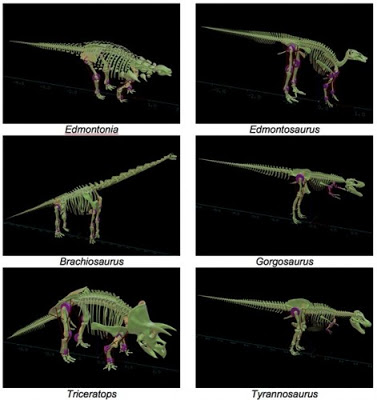
A lifelike model of T-Rex could be yours in time for Christmas, thanks to dinosaur experts from the University of Manchester.
The scary model is one of six remarkable skeletons developed by a team led by Dr Bill Sellers as part of research into understanding how dinosaurs move .
With the help of Manchester colleagues Dr Charlotte Brassey and Prof Phil Manning, the work was originally seen as a computer-based simulation as part of funder NERC’s 50th Anniversary Summer of Science.
But Dr Sellers converted the computer designs, based on work by artist and Southampton University PhD student Stuart Pond, to make them compatible with 3D printers.
Now anyone with access to a 3D printer—often found at schools, colleges and hack spaces—can download them for free from his website, to create a perfect gift for dinosaur fans.
The research team developed an open source computer programme so they could simulate the animals’ movement using ‘Kinect’, a motion sensing device popular with gamers.
Fans with some technical knowledge and a Kinect sensor can download the software to recreate the simulations see how good they are at making lifelike dinosaur movements on their home computers.
And if T-Rex is feeling lonely, there are five others who can cheer him up: Triceratops, Brachiosaurus, Edmontonia (an ankylosaur), Edmontosaurus (a duck-billed hadrosaur), and Gorgosaurus (a meat-eating theropod).
Dr Sellers said: “These models are amazingly accurate and a lot of fun; children will love them as will anyone who has an interest in dinosaurs. Just imagine their surprise when a lifelike model appears beneath the Christmas tree! If you haven’t got the time to 3D print the whole skeleton – you can just print out the skulls. They’re still very striking.”
He added: “But there is a serious side to this work too: We are interested in understanding how dinosaurs actually moved – and these computer simulations upon which the designs are based are very helpful in achieving that. The software doesn’t just animate the dinosaurs, it uses the Kinect PC interface to measure your body’s movements and then drives the muscles in the dinosaur simulations. These muscles generate forces and the software solves Newton’s Law’s of Motion to calculate how the dinosaur could actually have tried to copy your movement. So it’s about learning some physics, as well.”
Note: The above post is reprinted from materials provided by University of Manchester.










